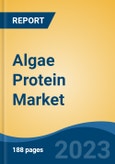Speak directly to the analyst to clarify any post sales queries you may have.
10% Free customizationThis report comes with 10% free customization, enabling you to add data that meets your specific business needs.
Algae-derived protein is now used in a variety of products such as energy bars, protein shakes, and plant-based meat alternatives, appealing to health-conscious and environmentally-aware consumers. Technological progress in algae cultivation, including innovations like photobioreactor systems and open-pond methods, is improving efficiency and reducing costs, making commercial scale-up more viable. The sector is further supported by favorable government initiatives and collaborative efforts between biotech companies, food producers, and research institutions aimed at advancing algae protein as a critical component of future global protein supply chains.
Key Market Drivers
Rising Demand for Sustainable Protein
Growing consumer demand for environmentally sustainable and plant-based protein sources is driving significant expansion in the global algae protein market. Microalgae and seaweed are gaining prominence as they provide nutrient-dense alternatives with a far smaller environmental footprint compared to traditional protein crops. Algae proteins are high in amino acids, antioxidants, vitamins, and omega-3s, appealing to both consumers and manufacturers across various food categories. Algae-based ingredients are being incorporated into a broad spectrum of products including supplements, snacks, and meat substitutes. Cultivation advancements like photobioreactors and open-pond systems have enhanced both yield and cost efficiency, paving the way for wider adoption. Notably, FAO studies indicate that microalgae can yield up to 15 times more protein per acre than crops such as soy, highlighting algae's potential in addressing global protein needs sustainably.Key Market Challenges
Scalability and Cost-Effectiveness
Despite its advantages, the algae protein industry faces persistent challenges related to large-scale production and cost competitiveness. Cultivation - especially of microalgae - requires sophisticated systems like photobioreactors or open-pond setups, which involve substantial initial investments and operational complexity. These systems demand meticulous control over environmental variables, adding to both logistical and financial burdens. Additionally, the processes involved in harvesting and drying algae are energy-intensive, which further inflates production costs. As a result, algae protein remains significantly more expensive than conventional sources such as soy or pea protein, posing a barrier to affordability and adoption in price-sensitive markets. Until technologies around automation, energy efficiency, and streamlined processing become more economically viable, achieving scalable production will remain a constraint on the industry’s broader growth.Key Market Trends
Growing Demand for Sustainable Proteins
A major trend influencing the algae protein market is the heightened consumer focus on sustainability. As awareness increases around the environmental costs of animal-based protein - including high greenhouse gas emissions and water usage - algae is gaining attention for its minimal ecological impact. Algae can be grown with limited land and freshwater resources and emits significantly less carbon than conventional protein sources.Its adaptability to controlled environments enables local production with reduced supply chain emissions. This sustainable profile aligns well with the rising popularity of plant-based and alternative diets such as vegan, vegetarian, and flexitarian. Consequently, food and beverage manufacturers are expanding their portfolios with algae-based products spanning meat alternatives, functional beverages, and clean-label supplements. These offerings are designed to cater to consumers seeking both nutritional value and environmental responsibility in their protein choices.
Key Market Players
- Corbion NV
- Cyanotech Corp
- Earthrise Nutritionals, LLC
- Far East Bio-Tec Co Ltd
- EID Parry India Ltd
- ENERGYbits Inc.
- Rainbow Light Nutritional Systems LLC
- NOW Foods
- Vimergy LLC
Report Scope:
In this report, the Global Algae Protein Market has been segmented into the following categories, in addition to the industry trends which have also been detailed below:Algae Protein Market, By Type:
- Microalgae
- Spirulina
- Chlorella
- Others
- Macroalgae
Algae Protein Market, By Source:
- Freshwater
- Marine
Algae Protein Market, By Application:
- Dietary Supplements
- Human Food
- Animal Feed
- Pharmaceuticals
- Others
Algae Protein Market, By Region:
- North America
- United States
- Canada
- Mexico
- Europe
- Germany
- United Kingdom
- France
- Italy
- Spain
- Asia-Pacific
- China
- Japan
- India
- Australia
- South Korea
- South America
- Brazil
- Argentina
- Colombia
- Middle East & Africa
- South Africa
- Saudi Arabia
- UAE
Competitive Landscape
Company Profiles: Detailed analysis of the major companies present in the Global Algae Protein Market.Available Customizations:
With the given market data, the publisher offers customizations according to a company's specific needs. The following customization options are available for the report.Company Information
- Detailed analysis and profiling of additional market players (up to five).
This product will be delivered within 1-3 business days.
Table of Contents
Companies Mentioned
- Corbion NV
- Cyanotech Corp
- Earthrise Nutritionals, LLC
- Far East Bio-Tec Co Ltd
- EID Parry India Ltd
- ENERGYbits Inc.
- Rainbow Light Nutritional Systems LLC
- NOW Foods
- Vimergy LLC
Table Information
| Report Attribute | Details |
|---|---|
| No. of Pages | 186 |
| Published | June 2025 |
| Forecast Period | 2024 - 2030 |
| Estimated Market Value ( USD | $ 4.89 Billion |
| Forecasted Market Value ( USD | $ 8.18 Billion |
| Compound Annual Growth Rate | 8.9% |
| Regions Covered | Global |
| No. of Companies Mentioned | 9 |









